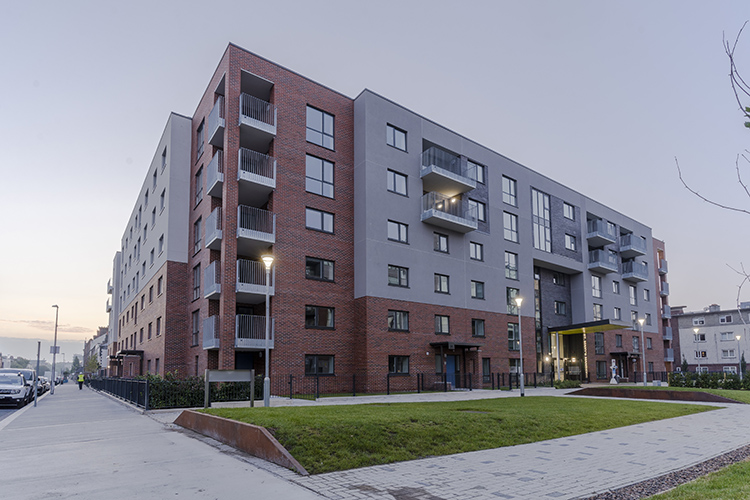
BRIAN O’GORMAN, CEO, Clúid Housing, speaks with Mimi Murray about the opportunities and challenges that Housing for All presents for social housing delivery.
Since 1995, the approved housing body (AHB) Clúid Housing has provided over 9,000 affordable homes to over 23,500 people in housing need across Ireland. According to its annual report for 2020, 76% of the 675 homes it handed over that year were new build, of which 268 were developer turnkey, 155 Clúid design and build and 93 developer design and build.
In 2021, Clúid launched its Greening Strategy: Building a Sustainable Future Together, in which it outlined its target to 2030 that all new Clúid homes will be netzero operational carbon and have 40% less embodied carbon, and all existing homes will be retrofitted to a minimum BER B2 rating.
Brian O’Gorman, Chief Executive Officer, Clúid Housing, was the AHB’s first employee and was appointed CEO in 2000. He has served as president of the Irish Council for Social Housing and was a member of the Dublin City Council Strategic Policy Committee for Housing. More recently, O’Gorman was appointed to the board of the new Housing Commission, which has been established under the Housing for All plan.
Brian O’Gorman has been a vocal proponent for the introduction of cost rental housing. He believes Housing for All is the first plan to be published by a government that sets out a clear vision to tackle the housing crisis, backed up with ringfenced funding.
“The Housing for All plan is very ambitious and positive overall,” O’Gorman comments. “With €4bn allocated annually over the life span of the plan, it has a large delivery pipeline. However, coming from a low base – 2.1% of GDP was spent on housing in 2020 compared to Germany where it was 7% – we’re catching up with a more European provision in terms of the allocation that is being made.”
Of specific relevance to Clúid is the planned 33,000 new homes each year, of which 10,000 will be social homes.
“The plan’s focus on new build will add to the stock rather than displacing existing stock. The cost rental allocation of 2,000 units per year is what they’re suggesting can be produced annually. There’s a lot to be welcomed in it, given that for the past few years it has been top of the political agenda,” O’Gorman says.
Clúid Housing funding
Last year, Clúid Housing had its best year ever in output terms. Despite restrictions, it delivered 968 homes.
“We’ve never had such success. The new homes are spread throughout the country, with much of the building in larger cities and commuter counties to Dublin, such as Kildare, Meath and Louth. Cork is also a big area as well as Limerick. The need is in the large centres,” he explains.
O’Gorman says that the secured funding over the number of years of the plan gives housing bodies security about planning for what they can deliver.
“The lack of surety on finance has bedevilled previous plans. Housing isn’t susceptible to an annual cycle. It needs to be planned across a number of years, so that defined funding over the coming years is very positive.”
Brian O’Gorman adds that he is delighted to see the commitment to cost rental housing in the plan.
“As a country, we have done social housing, private housing, private rental housing, but many low-income working households have struggled, as they have been confined to expensive private rental accommodation or insecure types of accommodation. Cost rental homes will provide secure and affordable housing into the future. Of all the Housing for All goals, this will be seen as the most important to come out of it.”
Housing for All challenges
But Brian O’Gorman says there will also be many challenges ahead in the delivery of the Housing for All plan, and some of these are already existing.
He explains: “The legacy defects from poor construction during the Celtic Tiger years are now having to be addressed. The real problem is that when you’re fixing up apartments, you’re not adding to the stock. It costs a lot of money, and it is a real challenge to new delivery if you continually have this legacy dragging you down. Retrofit is also costly but will not add significantly to the stock. It will also add additional pressures on the construction industry because of the level of manpower that will be required.”
Labour challenges
O’Gorman explains that the major issue that has been highlighted from Covid is a worldwide shortage of workers and skills.
“In terms of supply chains and materials shortages,” he says, “I think that it is temporary, and it will begin to work its way out. But, what isn’t temporary is the fact that we have this large, ambitious building programme but so does every other country in Europe. Workers from other European countries that were supplementing our own workforce are now in demand all over the continent. We need to retrofit, and it’s going to be much more expensive now as developers and contractors know their worth at this stage.”
Partnering with contractors and developers
Clúid regularly works with the same developers, which is something that works in each party’s favour.
“As long as we keep delivering for certain developers, they’ll come back to us. In the relationships that we have built, we know they can deliver, and they know we can deliver. These are partnerships we want to foster. The fact that there is a multi-annual programme is much more definite for them and offers more security. Because cost rental has been introduced, now we can talk to developers about a mixed tenure, social rental, cost rental and age-friendly housing and bring different components to their development programmes. That’s something extremely positive, and developers can have more confidence selling their private housing, knowing that certain components in the scheme are already paid for.”
Accessing land
One of the major problems for AHBs like Clúid Housing is that they don’t have landbanks, unlike local authorities. AHBs rely on developers coming to them with sites or state land becoming available.
“In Housing for All, there are a couple of mechanisms, one of which is the zoned land tax, and with these, the government is trying to increase the motivation for land to be developed. This should free up more development land.
“The initial plan for the Land Development Agency (LDA) was to coordinate the delivery of state land. The impression was given that there was lots of state land in different departments – Health, Education, for example – that was not being developed because there was land hoarding going on. For example, a specific tract of land may be needed for a future medical facility, so it may be held on to in some very strategic areas in cities. These huge plots of land could form a significant part of the land available to develop housing.
“Addressing access to land is probably one component of Housing for All that we see as extremely progressive. The fact that the government is tying Irish Water into that discussion is also extremely positive. In addition to the land being there, the infrastructure will also be in place in terms of water supply and wastewater.”
O’Gorman comments that it is about coordinating all the activities, and it has all the right aspirations.
“The LDA will ultimately be judged on how it manages to bring that large landbank through. For example, if you look at the Brugha Barracks discussions, where one minister comes out and says we’re going to develop lots of housing on Cathal Brugha Barracks, but another TD says it’s already housing military families. It’s not quite going to be as clear and clean-cut, but the intention is certainly there to use this land because it is prime development land.”
Cost inflation
During Covid, output was down, and building activity was held up for a period of time. Now activity has exploded in all quarters.
“Because supply chains are international, it’s been increasingly difficult to get materials, and we’ve seen prices soar. I think that will dissipate, and supply chains will come back to normal. But it won’t go back to where it was. So, the cost of construction will remain very high.“
Modern methods of construction
O’Gorman states that technology and off-site construction will be essential to delivery in the coming years.
“The use of modern methods of construction (MMC) such as modular housing, where homes are manufactured offsite in factory conditions then brought to site in panels to be erected is inevitably going to increase. It is also a much more assured way of developing and contracting. You don’t have the dependence on wet trades, it’s a much more predictable delivery on site, and as MMC becomes more mainstream, it will become a delivery game-changer,” he says.
“If you look at all the major developers and contractors, they all have tight partnerships or have bought over facilities that produce modular buildings. Once you have the land and it’s zoned, it’s a sweet spot to be in,” he comments.
In conclusion
Despite the challenges ahead, Brian O’Gorman is confident that the Housing for All plan will enable bodies like Clúid Housing to deliver much higher levels of social housing sustainably, and he looks forward to working with the government, developers and contractors to address this challenge in the coming years.
“With AHBs set to deliver 40% of all social housing as part of Housing for All, we want to be part of that new delivery process, and we have built up capacity to enable us to be part of it. We see that as an essential part of what we will be doing going forward. Housing for All has a significant emphasis on home-ownership, but for Clúid, the goal will be to build up our stock of long term cost rental or social rental and manage them in a sustainable way,” Brian O”Gorman concludes.



